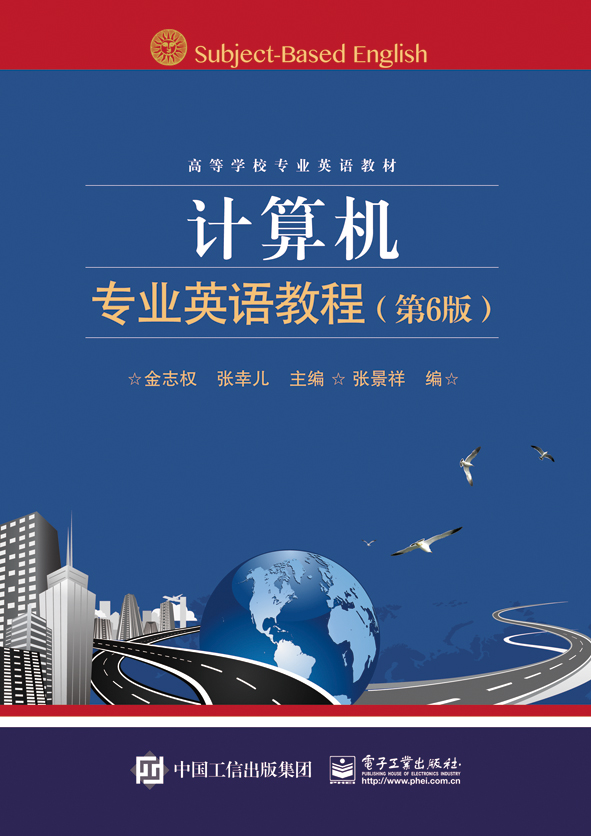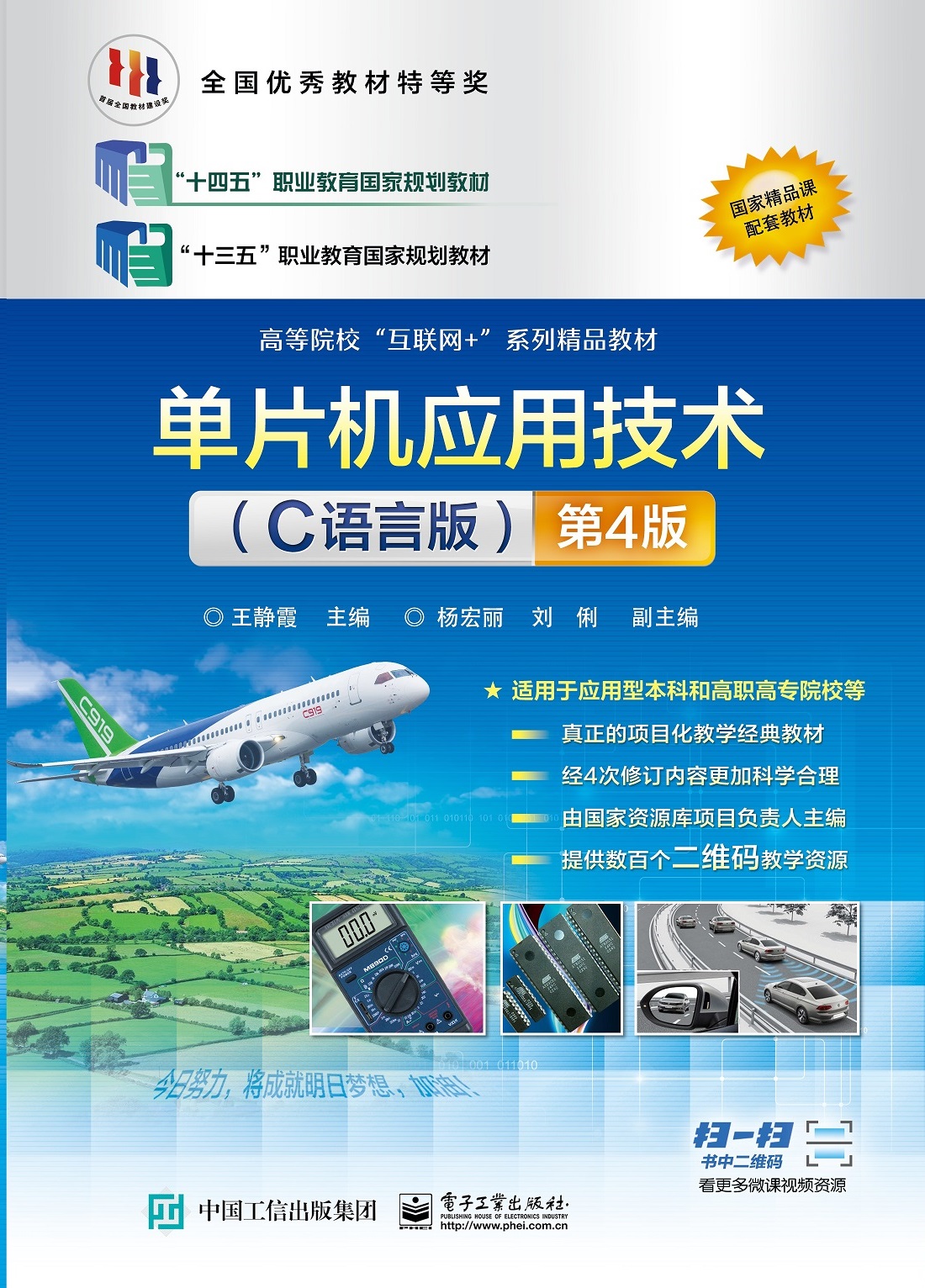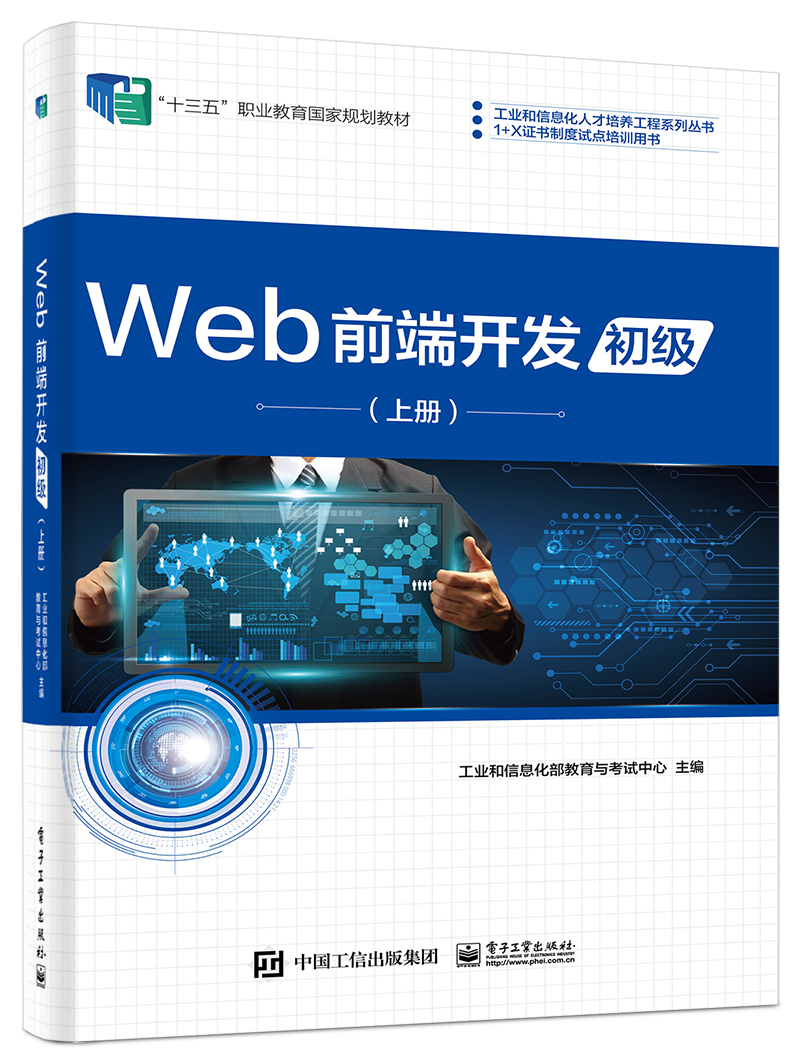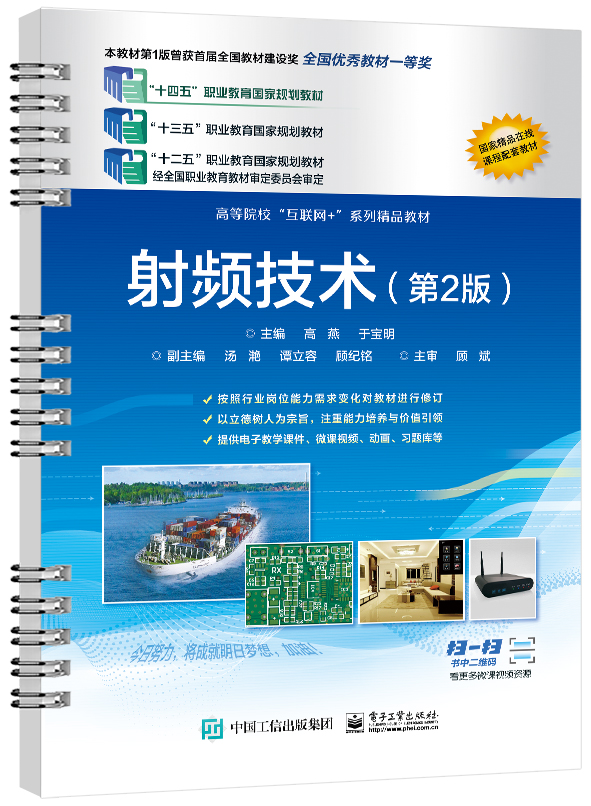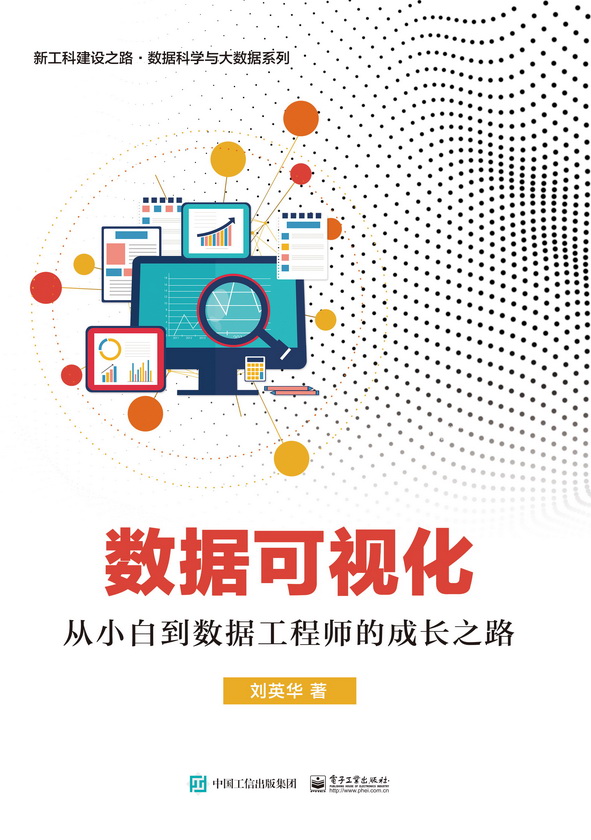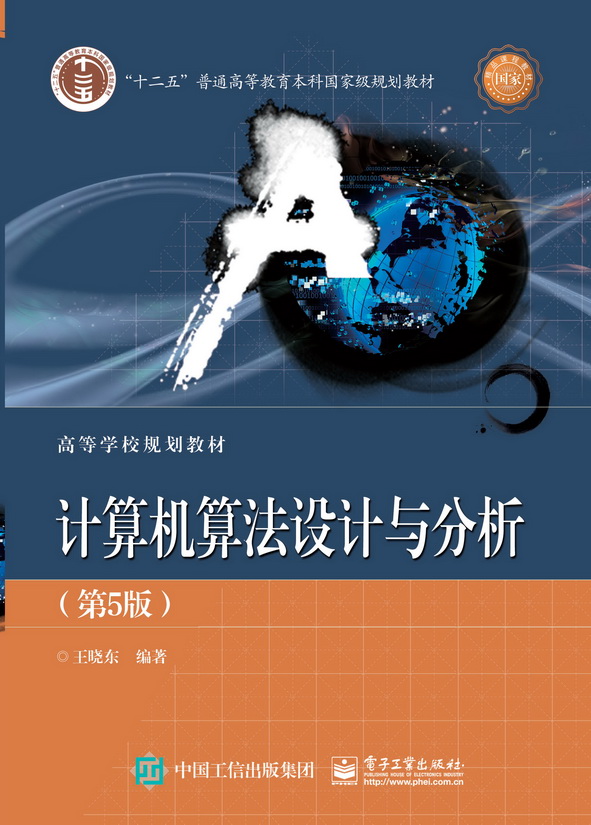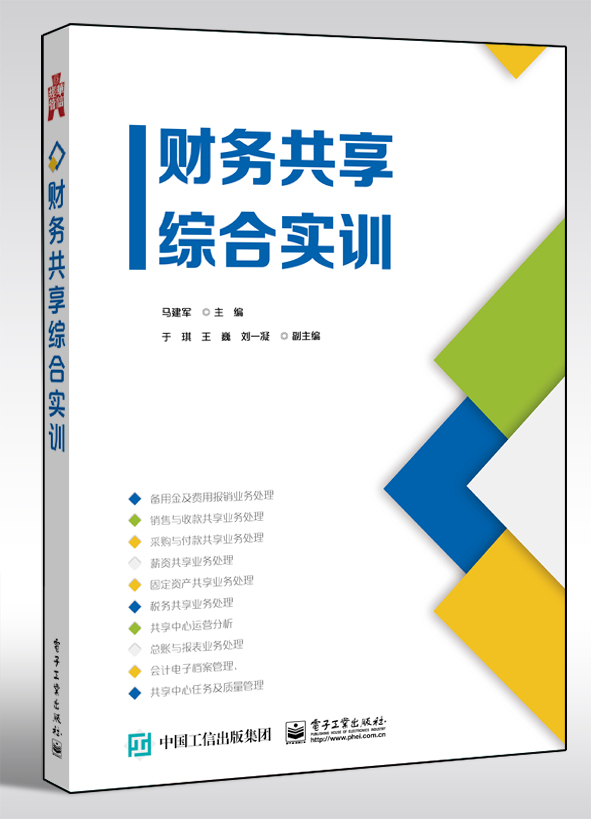计算机专业英语教程(第6版)(含CD光盘1张)
丛 书 名:
高等学校专业英语教材
作 译 者:金志权,张幸儿
出 版 日 期:2015-06-01
书 代 号:G0261311
I S B N:9787121261312
图书简介:
本书以计算机学科的各分支为基础,选取分支中的典型素材、新发展的简介以及最新和常用的术语,使读者能通过学习,从英语角度巩固和扩大计算机专业知识,同时及时了解计算机领域的新进展和新术语。 本书配有的注释和练习旨在提高读者阅读与笔译专业英语文献资料的能力,以及提高会看、会听、会说和会写的英语四会能力。 本书素材取自近年来国外计算机科学各领域的最新教材、专著、论文和计算机网络信息, 内容新颖、与时俱进、覆盖面广、结构合理、系统性强。为了方便读者,本书配有光盘,内容包含单词汇总、缩略语与术语索引以及部分音频和视频素材等。为了方便教学,另配有教学资源,向采用本书作为教材的教师免费提供,请登录华信教育资源网(www.hxedu.com.cn)注册后下载。
-
配 套 资 源
-
图 书 内 容
内容简介
本书以计算机学科的各分支为基础,选取分支中的典型素材、新发展的简介以及最新和常用的术语,使读者能通过学习,从英语角度巩固和扩大计算机专业知识,同时及时了解计算机领域的新进展和新术语。 本书配有的注释和练习旨在提高读者阅读与笔译专业英语文献资料的能力,以及提高会看、会听、会说和会写的英语四会能力。 本书素材取自近年来国外计算机科学各领域的最新教材、专著、论文和计算机网络信息, 内容新颖、与时俱进、覆盖面广、结构合理、系统性强。为了方便读者,本书配有光盘,内容包含单词汇总、缩略语与术语索引以及部分音频和视频素材等。为了方便教学,另配有教学资源,向采用本书作为教材的教师免费提供,请登录华信教育资源网(www.hxedu.com.cn)注册后下载。图书详情
ISBN:9787121261312开 本:16(185*260)页 数:344字 数:724.0本书目录
CONTENTS Unit 1 Hardware Ⅰ 1.1 A Closer Look at the Processor and Primary Storage 1.2 Integrated CircuitMoore’s Law 1.3 Multicore Processors 1.4 Computer Architectures Unit 2 Hardware Ⅱ 2.1 Optical Storage Media: HighDensity Storage 2.1.1 Optical Laser Disks 2.1.2 DVDs 2.2 Display Devices 2.3 3D Printing 2.4 The External Interface: USB Unit 3 Computer Programming and Programming Languages 3.1 Computer Programming 3.2 C++ and ObjectOriented Programming 3.3 JavaScript Tutorial 3.4 Introduction to Java 3.5 Characteristics of Web Programming Languages Unit 4 Operating System 4.1 Summary of OS 4.2 Using the Windows Operating System 4.3 Window Managers 4.4 Myths of UNIX 4.5 Using Linux in Embedded and Realtime System Unit 5 Computer Networks 5.1 Internet 5.2 Extending Your Markup: An XML Tutorial 5.3 Network Protocols 5.3.1 Protocol Hierarchies 5.3.2 WAPThe Wireless Application Protocol 5.4 Mobile Internet, Mobile Web Unit 6 Network Communication 6.1 Two Approaches to Network Communication 6.2 Carrier Frequencies and Multiplexing 6.3 Internet of Things 6.4 Wireless Network Unit 7 Database 7.1 An Overview of a Database System 7.2 Introduction to SQL 7.3 Objectrelational Database 7.4 Data Warehouse 7.4.1 Data Warehouse 7.4.2 What is Data Mining? 7.5 Big Data Unit 8 Multimedia 8.1 Introduction 8.1.1 Main Properties of a Multimedia System 8.1.2 Multimedia 8.2 Audio 8.2.1 Computer Representation of Sound 8.2.2 Audio Formats 8.2.3 MP3 Compression 8.3 Video 8.3.1 Video Compression 8.3.2 MP4 8.4 Synchronization Unit 9 Artificial Intelligence 9.1 Overview of Artificial Intelligence 9.2 About Expert System 9.3 Neural Networks 9.4 Industrial Robotics Unit 10 Data Structure and Algorithms 10.1 Abstract Data Types and Algorithms 10.2 Spanning Tree 10.3 Block Sorting Algorithms: Parallel and Distributed Algorithm 10.4 DivideandConquer Unit 11 Fundamentals of the Computing Sciences 11.1 Set Theory 11.2 Predicates 11.3 Languages and Grammars 11.4 FiniteState Machines Unit 12 Computer Applications Ⅰ 12.1 Computer Graphics 12.2 ComputerAided Design 12.3 The Virtual Reality Responsive Workbench 12.4 Graphical User Interface Unit 13 Computer Applications Ⅱ 13.1 Distance Education Technological Models 13.2 Electronic Business 13.3 EGovernment—Introduction 13.4 Office Automation Unit 14 Computer Applications Ⅲ 14.1 Geographic Information Systems (GIS): A New Way to Look at Business Data 14.2 Introduction to GPS 14.3 Management Information Systems (MIS) 14.4 Enterprise Resource Planning Unit 15 Software Development 15.1 Overview of Software Engineering 15.2 Unified Modeling Language 15.3 Integrated Computer Aided Software Engineering 15.4 Agile Software Development Methods 15.5 Middleware Unit 16 Network Security 16.1 What Do I Need to Know about Viruses? 16.2 Modern Cryptography—Data Encryption 16.3 Firewalls and Proxies Unit 17 Some Computer Systems 17.1 Embedded Systems 17.2 Distributed Systems 17.3 Cloud Computing and Cloud Storage 参考译文 1.2 集成电路——摩尔定律 2.4 外部接口: 通用串行总线 3.2 C++和面向对象的程序设计 4.4 UNIX的神话 4.5 在嵌入式和实时系统中使用Linux 5.3.1 协议分层 6.1 网络通信的两种方法 6.4 无线网络 7.1 数据库系统概述 7.5 大数据 8.3.1 视频图像压缩 9.2 专家系统 9.3 神经网络 10.3 块排序算法:并行和分布式算法 10.4 分治法 11.2 谓词 12.3 虚拟现实响应工作台 12.4 图形用户界面 13.1 远程教育技术模型 14.1 地理信息系统(GIS):查看商务数据的新方法 15.2 统一建模语言 16.2 现代密码学——数据加密 16.3 防火墙和代理 17.3 云计算和云存储 Bibliography展开前 言
前言 自本教程第5版出版以来,以下几方面的发展无疑需要反映在新的一版中: ● 越来越多的人在他们的路上使用智能手机等移动设备,经由蜂窝网无线访问Internet和Web。 ● 云计算和云存储应用已相当普遍。 ● 物联网不断发展。 ● 可穿戴式设备不断出现。 ● 包括上述的种种网络应用,使得最近几年产生了前所未有的巨量数据,这种大数据已超出传统的数据库管理系统的处理能力。 ● 3D打印已广泛应用于航空航天、军工、建筑工程、汽车业、牙科和医疗工业、生物技术、个人化定制等领域。近年来中国先进战机密集亮相正是得益于钛合金3D打印技术的突飞猛进。该技术在珠宝、鞋类、工业设计、工程和施工(AEC)、教育、地理信息系统、土木工程以及其他领域都有所应用。 ● 我国创新技术取得令人瞩目的成绩,在新产品的设计、3D打印等应用中广泛使用二维、三维图,表明计算机图形学得到更为广泛的应用。 ● 微信超过微博成为最受欢迎的平台。过去的博客、维基、Facebook、YouTube、MSN、Skype等都是美国等开发的,而微信是首款由中国人开发的。 为此,第6版增加以下8篇课文:Mobile Internet and Mobile Web,Cloud Computing and Cloud Storage,Internet of Things,Big Data,3D Printing,Computer Graphics,GUI,Integrated Computer Aided Software Engineering,并附有部分参考译文。 此外,增加如下新术语:smartphone, tablet computer, ultrabook, bluray disc, TFTLCD, Android, WeChat, Web crawler,cellular network,2G,3G, 4G,UMTS,AES,WPA,WPA2,PSK,distributed database, intelligent database, granular computing, API, CES, wearable computer等。 与此同时,把第5版的Bus Interconnection等11篇课文放到本书配有的光盘中,以减少书的篇幅。 为了便于读者查阅,提高听力,第6版仍备有光盘,供读者使用,其内容包括 ● 单词汇总 ● 缩略词、术语索引 ● 参考文献 ● 视频素材 ● 每个Unit两篇课文的英文朗读材料 ● 前几版中所被删除的课文 本版保持了前五版的编排格式和基本风格。各校教师可根据自己的具体情况,因材施教,在每一个Unit里挑选课文进行教学。本书每个Unit都给出了看、听、说、写四种练习题。进行英语口语练习时,可结合所列题目,组织学生进行课堂小组讨论或讲述。为了方便教学,本书另配有教师用资源包,内容包含电子教案、中译英练习题参考答案、视频素材的参考原文、若干课文参考译文以及授课建议,向采纳本书作为教材的教师免费提供(获取方式:登录电子工业出版社华信资源网www.hxedu.com.cn或电话联系01088254531)。 全书共分17章,第1、2、4、5、6、8、10、16、17章由金志权编写,第3、7、9、11、12、13、14、15章由张幸儿编写,并彼此进行了互审。本书的电子教案由济南大学张景祥编写制作。 在此感谢对本书的编写给予帮助的南京大学陈珮珮、李存珠、陆钟楠、张福炎、李宣东、徐洁磐、蔡士杰、邵栋、黄皓、宋健建等老师,南京大学外国语学院王守成、杨治中、侯焕谬、张子清等老师,南京师范大学顾铁成老师。感谢张凌绮、Jimmy Jin、Amanda Fang、Steven Fang在课文朗读、视听素材收集和整理上给予的支持。感谢天津大学计算机科学与技术学院戴维迪博士、苏州科技学院傅朝阳博士、广西科技大学阳树洪博士、海南大学冯思玲老师、南京理工大学鲁加军老师、河北唐山学院王永强老师、浙江财经大学东方学院张琼妮老师等的关心与支持。同时还要感谢丁正全、张万华、韩杰等提供的帮助。在此我们一并表示诚挚的感谢。 限于作者水平,书中难免会有不妥和错误之处,敬请读者批评指正。 反馈意见请发邮件至:jinzq@software.nju.edu.cn;zhangxr0@sina.com;zhangjx@ujn.edu.cn。 编 者 于南京大学展开作者简介
本书暂无作者简介 -
样 章 试 读
-
图 书 评 价 我要评论
